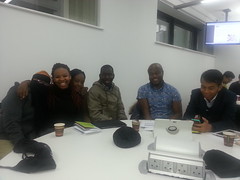 I had the chance to meet with two brilliant self-taught analysts at Boohoo.com, Jenna and Dan E. who both have an unexpected past. They gave me an insight into business intelligence, data analysis and UX, and some great advice that I decided to share with you in this post.
I had the chance to meet with two brilliant self-taught analysts at Boohoo.com, Jenna and Dan E. who both have an unexpected past. They gave me an insight into business intelligence, data analysis and UX, and some great advice that I decided to share with you in this post.
Two months ago Boohoo.com, the online retail store, organised an event for students and graduates to introduce them to the job opportunities available at the company. The event itself was more of a marketing event to introduce people to the “We are us” brand but it allowed people to network, meet the team, ask about the different job/internship/placement opportunities; someone even secured a summer internship.
I had the pleasure of meeting Jenna. I really liked the short presentation on the insight (business intelligence) team so I approached her. Jenna had a rough past; she went through some challenging experiences and through hard work got where she is now. What I remember most from our conversation is her telling me “If I can do it, anyone can do it” (she forgot to add “if you are as driven and smart as she is). She invited me to come see her at work, an invitation that I accepted last week (I have been busy with my dissertation).
Super Jenna squeezed me into her busy schedule and arranged for me to see people from the insight and the e-commerce teams.
After going through the labyrinth of an office that is the Boohoo.com headquarter, grabbing some smoothies from the beautifully designed Attics shops (Jenna kindly offered me one), I met Darren who is the business intelligence, the smart one, Jenna says. I started in the insight department where Jenna introduced me the business intelligence system, Qlikview. Qlikview is a platform that allows the merger, the search, the viewing and analysis of all data giving a “full insight” of the performance of sales, products, pages, PPC, and other organisational elements. The analytic platform runs reports and creates dashboards that detect market changes and product sales. Jenna showed me some of the software features, the ones she mainly uses, including business management, Excel reports, automatisation, bookmarking and creating labels.
Between a sip of those delicious smoothies and our talks about projects on homelessness Jenna manage to squeeze in some tips on things to focus on and which I can teach myself. So if you would like to become a business intelligence consultant or work in similar area here some things to focus on or even if you have an online business:
- Qlikview – It is available online for free, you will only need to pay for licenses to share reports on different systems. There are online communities including one the Qlick website to help you start up and communities for more advanced users. You will appreciate its compatibility to MSExcel and MS Access. For more information on the product you can check the detailed reviews on G2crowd.
- Tableau – is an alternative to Qlikview. For those who have used Google Analytics before, you will appreciate that the design is similar and it does not require technical skills (while you may need some SQL skills to set up the report automatisation on Qlikview). You can also get extra reviews on G2crowd.
- SQL – Jenna advised to learn SQL language online. You can find some good tutorial on search engines.
- MS Excel – This tool can be used in any industry and in any field of work (really, from logistics to banking and from finance to marketing, everyone uses Excel) so it is definitely worth mastering it.
So that was my day with Jenna. I came back two days later to steal Dan E.’s last few hours before the weekend. He is a politics major who train himself to becoming an analyst (he is also geek he says). Dan E. is part of the UX (user experience) and e-commerce team and mostly works with Google Analytics. He measures customer trends, journey through the website against goal metrics and works on improving UX and thus sales.
Seating in the Boohoo.com Attics shop, Dan E. explained the ways the customer experience was tested, how the data about trend was collected, and other elements such as targets, data source and data interpretation. Unfortunately he was not allowed show me the company’s Google Analytics account or the actual tests being ran on the website but his examples were specific enough for me to get a clear picture of what the UX and e-commerce team does (my dream job), how they use trends and data, and how UX can be tested to improve sales.
This is what is to be remembered about analytic from the hour-and-a-half conversation:
- Data is expansive – There is no way you can use everything or see everything.
- Always start with a hypothesis otherwise it is like “searching for a needle in a sack of needle”. Starting with a hypothesis will give you some direction and will keep you focused otherwise you might find yourself dealing with extensive data. You can then focus on proving or refuting the hypothesis.
- Every industry is different – There is no general advice with regards to when, how or how often to review your hypothesis. In term of trends, mood and speed each company is also different. In the case of Boohoo.com for example it’s a fast pace online retail firm that needs constant reviewing of UX on different pages or innovative UX for each country.
All in all this was a really insightful unique experience. My final advice for you is to approach the company you would like to work for or a company in the same industry and checking if the company, the industry or even the position is right for you.
Thanks to Jenna for organising this visit and to Dan E. for taking time off his busy schedule.












